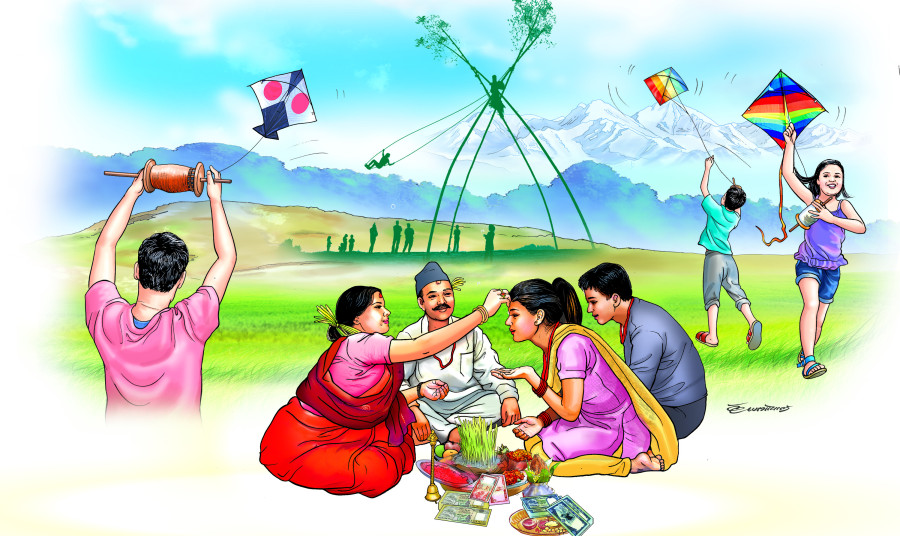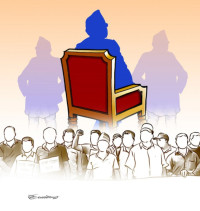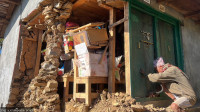Columns
The ritualisation of collective memories
As festivals become cultural practices with prescribed rituals, their socio-economic origins are forgotten.
CK Lal
On the fourth day of the five-day Tihar festivities, an enterprising person had fastened an ox to a temple pillar for the convenience of worshippers. Perhaps the bovine was transported from somewhere outside of Kathmandu Valley in a truck and then tethered by the side of a Shakta shrine close to a busy street. The ox appeared dazed, and its eyes looked glazed as it tried to yank some marigolds off garlands that the worshippers had put around its neck.
Despite the relative flatness of rice paddies along riverbanks in the Nepal valley, the Newa community have historically resisted the temptation of using bullocks for pulling ploughs or drawing carts. Since the Nandi bull is revered as the sacred mount of Lord Shiva, all bullocks are deities requisitioned on Goru Tihar even in the hills and mountains where its utility as a drought animal is considered either impractical or sacrilegious.
The importance of the bull for the cowherds of the Gopal kings that ruled over settlements in and around the Nepal valley nearly 3,500 years ago is indisputable. However, it wasn’t as inseparable with the everyday life of the pastoralists as with the farmers in the Indo-Gangetic Great Plains. Rather than castrate and domesticate male calves, cowherds allowed their bulls to roam free in the wilderness.
One hardly needs to dedicate a day to worship the oxen as every day is the bull’s day in the Kathmandu valley. Ritualised practices, however, acquire religious, spiritual, or cultural connotations after multiple repetitions over time and become an integral part of the collective behaviour.
Since events, personalities, practices and experiences aren’t always recorded, it needs constant retelling and multiple recounting for the remembrance of the past to solidify into myths of collective memory. Every narration, however, is a recreation—sometimes even a complete fabrication—of an imagined rather than an authentic past.
Most, if not all, festivals are about collective memories: Various stories about a successful hunt of a dangerous predator in the land or water, the victory of a tribal chieftain over a more powerful aggressor, the sacrifice of a holy soul for the good of all, the challenges of sowing or the joys of harvesting and sometimes just the celebration of a pleasant season.
Layers of legends and myths get added to various memorialised days as they become common festivals of the yearly calendar in different parts of the world. Since Hinduism is a collection of faiths with multiple deities and many sacred texts, unlike religions of “one God, his chosen Messenger and the holy Book”, it has more festive occasions of fasting, feasting and merrymaking than almost any other culture. But the dual processes of Brahmanisation of indigenous practices and marketisation of traditions have turned almost every festival into an event of ostentatious celebration, conspicuous consumption and thus invariably an expensive affair.
Cultural Sanskritisation
When sociologist M.N. Srinivas (1916-1999) found that the “process by which a low caste or a tribe or a group changes its customs, ritual, ideology and way of life in the direction of a high twice-born caste” was more than Brahmanisation and included the adoption of lifestyles of dominant castes by the aspiring section of the erstwhile dominated groups, he began to use Sanskritisation for the method of upward mobility. Analogous to modernisation in many post-colonial cultures, Sanskritisation was the preferred way of establishing acceptability in the Chaturvarna society.
The process of Sanskritisation transforms existing practices, absorbs folklores, co-opts tribal heroes, pulls myths into Sanskrit texts, renames rituals and adopts local deities as different avatars of the Hindu Trinity or the eternal Shakti. Last, but not the least, it often institutes a role for the Brahmin priests. Eventually, the socio-economic origins of a festive occasion are forgotten as it becomes a cultural practice with its prescribed rituals. Through multiple repetitions, memories get modified, and then a sanctified way of celebration is eventually established.
It's possible to argue that Dashain in the mountains and valleys of the Mahabharata Ranges signified the end of monsoon: A short interlude of autumn for hunter-gatherers, a brief break for the farmers before the harvesting began, an occasion for tradesmen to embark on a journey to or from home, a sunny but balmy weather for everyone and hence a time to show one’s gratitude to Mother Nature through a family affair.
The Shakta sect first appropriated Dashain through the legend of Mahishasura Mardini—a form of Durga, the fierce protector of durg, the Sanskrit term for fortress. The Vaishnavas of the Ganga plains added the lore of Lord Ram burning demon-king Ravana with fiery arrows. Adherents of the Shaiva sect are indifferent to the religious significance and continue to mark Dashain as a cultural event of family reunion with food, drink, songs, dance and games.
Mindless marketisation
The Brahmanisation process of Sanskritisation seems to have mutated into Vaisyakaran or commercialisation of festivals with manipulators of the market pushing conspicuous consumption and pretentious religiosity. It made sense to get new clothes before Dashain to prepare the family for the coming winter, but luring gullible masses into borrowing to buy consumer durables that they can ill-afford is a symptom of mindless marketisation.
Somewhat like Dashain for the hunter-gatherers, the Yam Panchak probably began as a tribute to the forces of nature after the farming revolution that made a settled life possible: Crows as a sign of human habitation, dogs as guards of cattle, cows as givers of milk, oxen as pullers of plough and finally the bonding between brothers and sisters to keep the extended family intact.
The day of the crow (Kaag Tihar) was first appropriated as the Dhanbantari Jayanti to honour the healer-sage of yore. Then it became the day to mark the acquisition of household goods and now more gold is sold and bought on the “day of good health”, which has now become Dhanteras, than any other occasion. Adherents ritually worship crows, dogs, cows and oxen but alarm pet parents and frighten birds and animals by bursting firecrackers.
Incidentally, legends of Nepal Sambat of Newa community (the largesse of Shankhadhar Sakhwa) and Bestu Varas (Lord Krishna protecting pastoralists from the fury of Indra) of Gujratis are different, but both mark the beginning of a new accounting year for the traders. The season of festivities will end with the five-day-long Chhath Mahaparva of the Greater Mithila that includes large swathes of land where Bajjika, Bhojpuri, Hindi, Magahi and Nepali are the chosen languages of communication now. It has spread with the diaspora of the region all over the world.
Just as Dashain and Deepawali were folk festivals before Sanskritisation, Chhath was a penance of commoners to appease Mother Nature present in the five elements of life: Earth, fire, water, air and sky. The word Chhath is said to be derived from Shashthi Tithi, but Chhaith in Maithili simply meant ‘She is’: Omnipresent, timeless, formless, nameless and generous. Sneaking Sanskritisation is ritualising observance, creeping commercialisation is leading towards competitive display of wealth and misguided marketisation is adding land, air, water, fire and sound pollution. May Chhathi Maiya forgive her devotees who have forgotten the inviolability of Mother Nature and bless us all with health, happiness and mindfulness.



 13.12°C Kathmandu
13.12°C Kathmandu















